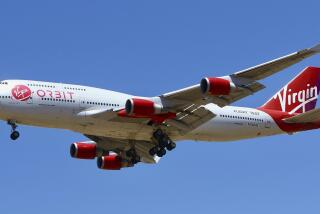Lockheed Sets Stock Plan for Workers, Will Shed 4 Units and Land
After being a potential takeover target for years because its shares are considered undervalued, Lockheed unveiled a corporate overhaul Tuesday that includes an employee stock ownership plan, sale of some Burbank real estate, disposal of smaller operations and a dividend increase.
In addition, Lockheed Chairman Daniel M. Tellup disclosed that the Calabasas-based aerospace firm is holding discussions with McDonnell Douglas on a potential subcontracting deal to assemble stretched MD-11 jetliners and with Netherlands-based Fokker for the assembly of F-100 jetliners.
The major restructuring, which is intended to improve the value of Lockheed shares and reinforce defenses against corporate raiders, came one day after Texas investor Harold C. Simmons disclosed that he owns 5.3% of Lockheed’s shares.
Tellup said the restructuring has been in the works since last fall and that the announcement of the plan Tuesday was only coincidental to Simmons’ disclosure Monday. Tellup said he does not regard Simmons’ $150-million investment in Lockheed as the start of a hostile takeover effort.
“All of the actions had the overarching objective of increasing shareholder value and positioning Lockheed for long-term growth,” Tellup said at a news conference Tuesday morning in Calabasas. “Nothing we do can prevent a fair value offer (by a corporate raider).”
Simmons reacted negatively to the restructuring effort, saying: “I’m disappointed. I hadn’t expected them to react like this to my investment. It’s not good value for the shareholders. I’m considering selling some or all of my stock. I made an investment based on the outlook for the company and the aerospace industry.”
Lockheed shares gave up $2 in New York Stock Exchange trading Tuesday, closing at $47.75. On Monday, they had gained $3 on news of Simmons’ investment in the company.
Lockheed also disclosed Tuesday that it expects that its 1989 earnings from continuing operations will decline by 25% from the $442 million reported in 1988. The decline is attributable to completion of the C-5B cargo jet program, high tax rates and cost increases in some other military programs, the company said. But profits should grow in 1990 and beyond, Tellup said.
Under its complicated restructuring plan, Lockheed created an employee stock ownership plan that acquired about 10.5 million shares of newly issued Lockheed stock for $500 million. The ESOP borrowed the money to pay Lockheed for the stock.
At the same time, Lockheed has started buying back 10.5 million shares of its stock on the open market, thereby eliminating any dilutive effect that the newly issued stock would have on existing shares.
Tellup said the ESOP, whose participants will be salaried employees, is expected to “get employees more involved and productive” and secondarily may be a takeover defense. After the ESOP is in place and all the outstanding shares are repurchased, Lockheed employees will own about 17% of the company’s stock, a voting bloc that could help thwart a hostile takeover effort.
The company also disclosed that it will accelerate by one year the plans it disclosed in 1988 to move virtually all manufacturing, parts fabrication and engineering activities out of Burbank to newer facilities in Palmdale, Rye Canyon and Marietta, Ga. The move will be completed in 1991.
About 7,000 employees will move to new job locations, leaving about 7,000 behind in Burbank. The move may result in some layoffs, but no more than 300, Tellup said.
After vacating the aged Burbank facilities, some of which were constructed during World War II, Lockheed will sell about 225 acres of valuable land adjacent to the Burbank airport. Tellup said the company does not have an estimate of the value of the land, but commercial land brokers have said the land is worth more than $1.5 million per acre, indicating that the 225 acres might be worth more than $337 million.
The company will keep the headquarters of its Lockheed Aeronautical Systems Co. in Burbank, where Lockheed has been building aircraft since 1928 when founder Allan Loughead moved his small airplane company into a former china factory there.
Tellup said he hoped that the move of 7,000 employees, mainly to Rye Canyon near Valencia and Palmdale, will be accomplished with a minimum of disruption. Company surveys have indicated that many workers will not have to move from their present homes, he said.
Another element of Lockheed’s restructuring is a plan to sell the parts of its information systems group, including CalComp of Anaheim, CADAM of Burbank, Metier of Burbank and Lockheed Dataplan of Los Gatos. The four companies had 1988 revenue of $589 million. They are believed to be more profitable than many of Lockheed’s weapons contracts, but Tellup said the company wants to focus on its primary businesses.
Lockheed will also form a new anti-submarine warfare office in Washington in an effort to win contracts in that growing Navy market. Lockheed is building the Navy’s Long Range Air Antisubmarine Capable Aircraft, which has recently been renamed the P-7.
In a final reorganization move, Lockheed will create a new technology services group to consolidate such operations as space shuttle processing, engineering sciences, data processing, and aircraft and airport facilities modernization and maintenance. The group will have $1 billion in revenue and is expected to build up “entrepreneurially,” Tellup said.
McDonnell Douglas spokesman Don Hanson confirmed that talks with Lockheed have been conducted, but he said they are “preliminary.” He said the discussions involve final assembly of a stretched version of Douglas’ new MD-11 wide-bodied jetliner.
“There is no decision on what would be the fate of future MD-11 assembly and there won’t be any soon,” Hanson said. “There is not that much hurry about getting that decided.”
The first MD-11 is expected to begin test flying in May and to enter commercial service next year.
More to Read
Inside the business of entertainment
The Wide Shot brings you news, analysis and insights on everything from streaming wars to production — and what it all means for the future.
You may occasionally receive promotional content from the Los Angeles Times.











